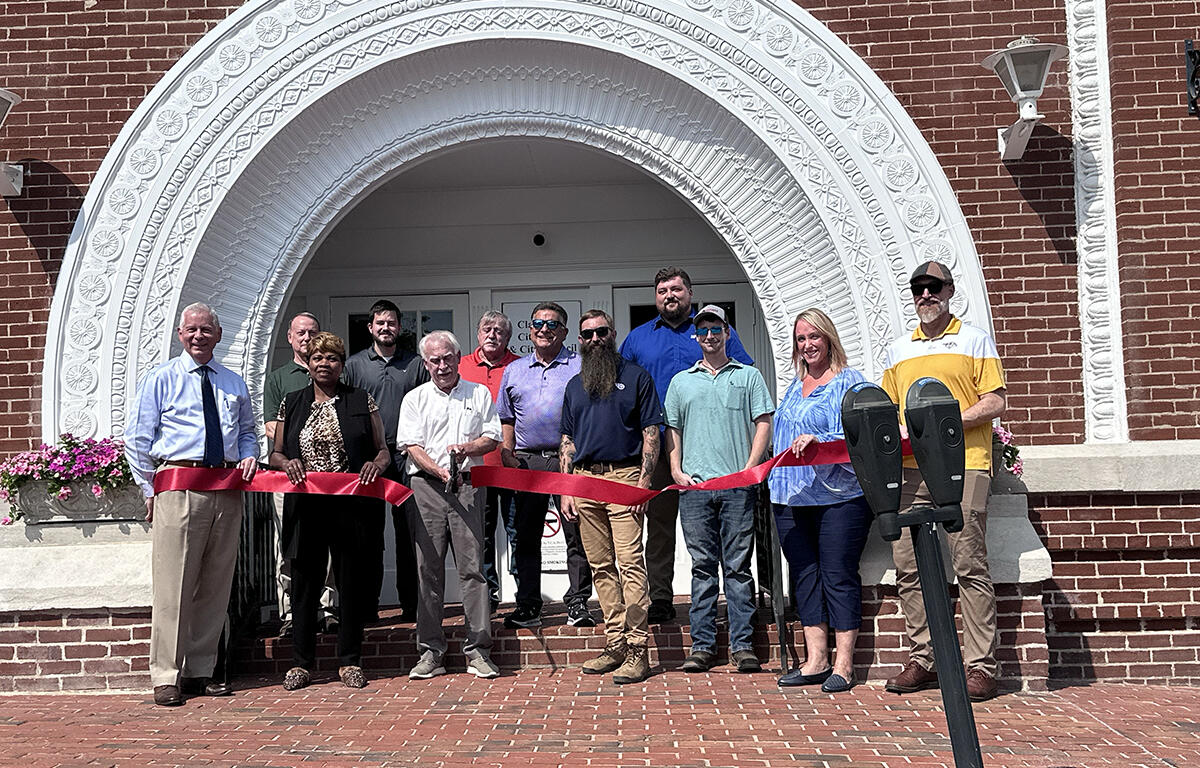CLARKSVILLE, TN (CLARKSVILLE NOW) – The archway above the old City Hall at 106 Public Square, which was recently reconstructed as a collaborative effort to restore historic downtown, was unveiled at an official ribbon cutting this week.
Charlie Foust, president of the Clarksville Foundry, cut the ribbon surrounded by Mayor Joe Pitts, City Council members Deanna McLaughlin, Brian Zacharias and Wanda Smith, as well as several of those involved in the restoration project. “It’s not every day you get to work with the fine folks in the city of Clarksville,” said Foust.


Preserving Clarksville history
The archway is just a smaller piece in the bigger project of preserving the history of Clarksville. Other projects, such as the Smith-Trahern Mansion, L&N Train Depot and Riverview Cemetery, have all been restored recently to protect these sites.
“You know as this city continues on a very torrid pace of growth, we’re seeing buildings that once stood proud and heralded our place in history become run down and in need – great need – of repair,” Pitts said. “But the City of Clarksville over the past few years is doing our part to ensure our buildings and places don’t suffer the same fate.”
| GET YOUR MORNING NEWS: Sign up for the free daily Clarksville Now email newsletter
Pitts recognized the project management team responsible for assembling this particular project, as well as the companies that made it happen. The design specifications were the work of Lane Lyle from Lyle-Cook-Martin Architects, and the craftsmanship of the arch was by contractors B.R. Miller & Company.
The “secret weapon,” according to Pitts, was the Clarksville Foundry – the glue putting this project together. The foundry has been operating for 178 years in innovative iron-casting and had a major role in the construction of the arch.









Behind scenes of arch restoration
In the beginning of the restoration, collaborators identified the original material of the arch to be terra cotta, the same material used to make clay flower pots. The question of being able to cast the material arose, due to the size being 16 feet across, according to Clarksville Foundry.
Once B.R. Miller & Company received a permit to renovate the exterior of 106 Public Square in April 2024, the work began. In May 2024, the original arch pieces were carefully removed. Each piece was then documented to preserve its historical significance.
| DOWNLOAD THE APP: Sign up for our free Clarksville Now app
The structure was digitally scanned and uploaded into an electronic program, ensuring the project was precise. The city of Clarksville and Lyle-Cook-Martin contracted Todd Marchand of Petrus LLC to create 3D models of the components using some of the original terra cotta pieces.
The arch ended up being done in segments and assembled, then duplicated in cast metal by the Clarksville Foundry in the different segments. “This was far more complicated than anyone ever imagined,” said Foust.
Building arch at Clarksville Foundry
The models created by Marchand were provided to Dillon Nottingham, the Clarksville Foundry’s engineer, to assemble them into a solid model of the entire arch.
In metal casting, workers start with a pattern that is embedded in sand and withdraw it, creating a cavity to then fill with liquid metal to solidify. Due to the complexity of the design, it was clear to the foundry workers that the conventional methods of casting were not the best choice.
Approximately 1,450 pounds of aluminum were melted in Clarksville Foundry’s crucible furnace and carefully poured into the sand molds. Once the metal solidified, it captured the precise contours and features of the arch components.
After all the components were completed, 36 separate castings were made.
“I can tell you that the whole process was not without a hiccup or two. However, through sheer determination, the project was completed as can be seen right here in front of you. Clarksville Foundry is very proud of the result and its role in the project,” said Foust.
Correction: Dillon Nottingham’s name was misspelled in an earlier version of this report.
| NEW TO CLARKSVILLE? Check out our Newcomer’s Guide


